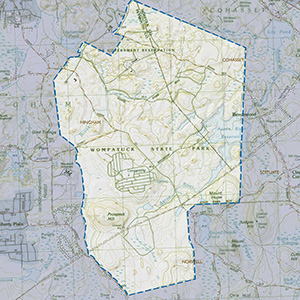Important Bird Area Sites in Massachusetts
Important Bird Area: Wompatuck State Park
Site Summary
Nominated By
Dennis Peacock
Size
3,500 acres
Towns and Counties
Cohasset, Hingham, Norwell, Scituate; Plymouth
Ownership
Department of Conservation and Recreation
Major Habitats
oak-conifer forest 60%, palustrine woodland swamp 30%, river/stream 2%, early successional shrubland, lake/pond, migratory stopover site
Land Use
nature & wildlife, conservation/land trust, other recreation
Serious Threats
cowbird parasitism
Minor Threats
introduced animals/feral pets, recreation development/overuse
IBA Criteria
- Category 2: Sites containing assemblages of species characteristic of a representative, rare, threatened, or unique habitat within the state or region.
- Category 4: Land Birds: The site is an important migratory stopover or seasonal concentration site for migratory land birds (e.g., warblers). Sites may also qualify on the basis of supporting exceptionally high densities of breeding species as shown from point counts or other surveys or if they represent "migrant traps" relative to surrounding areas. Strong consideration will be given to areas with consistently high overall species diversity.
Site Description
Wompatuck State Park comprises 3,000 acres of eastern transitional forest and various other habitats. It is located within one mile of the ocean. Habitats include semiconserved oak-conifer transitional forest, hemlock groves, ponds, palustrine wooded swamps and early successional shrubland. Wompatuck is quickly becoming recognized as an enormous migratory bird trap and as home to an abundance of breeding birds including many species deemed high conservation priority.
Current Conservation Status
The Hemlock Woolly Adelgid poses a threat to Eastern Hemlock, which could result in the disappearance of breeding Louisiana Waterthrushes because their habitat may be diminished if not eliminated with the demise of hemlock. Although nothing is currently planned for development, the threat of expansion of campgrounds, parking lots, and other "improvements" is possible. Existing leash laws are not enforced, and roaming dogs are to be found everywhere at almost all times.
Ornithological Significance
At least 25 regional high conservation priority species have been observed during migration. Fifteen regional and six state high conservation priority species breed in the Park. The park hosts a preponderance of Eastern Towhees, Veeries, and Wood Thrushes. The habitat types and their regional uniqueness are reflected in the presence of several locally uncommon breeding species: Barred Owl, Black-billed and Yellow-billed Cuckoos, Hairy Woodpecker, Acadian Flycatcher, Worm-eating Warbler, Northern and Louisiana Waterthrushes.
Other Flora or Fauna of Significance
The following Species of Concern occur at this park: Blue-spotted Salamander, Spotted Turtle, Wood Turtle, and Mocha Emerald. State watch list species include Eastern Box Turtle.
Data Sources
J. Flaherty. 1986. Birding Wompatuck State Park. Bird Observer, 14: 116-124.
D. Peacock. 2001. Birding Wompatuck State Park.Bird Observer, 29: 95-101.
D. Peacock, personal observations, April 1998-July 2001.
Personal correspondence with: Scott Peacock, South Shore Bird Club; Steven Peacock, South Shore Bird Club; Wayne Petersen, Mass Audubon; David Larson, Mass Audubon; Glen D'Entremont, Brookline Bird Club




